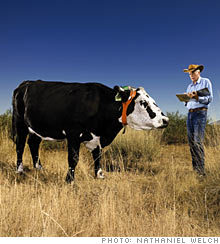High-tech wranging: Remote-control your cattle
Two scientists chase their dream of GPS-enhanced cows.
 |
| Dean Anderson reads to one of "his girls," shown wearing the Ear-a-Round GPS tracking headset. |
(Fortune Small Business) -- Building and maintaining fences for cattle is a time-consuming and costly endeavor. Materials alone can run $8,000 per mile. Add in repair costs for damages caused by wild animals and toppled trees, plus the expense of retrieving cattle when they stray, and it's no wonder ranchers dream of easier ways to keep track of their herds.
"Ranchers are willing to look at just about any new technology that will save them time, labor and money," says Jon Wooster, president of the U.S. Cattlemen's Association.
Even a GPS headset for cattle - which Dean Anderson and Daniela Rus are ready to give to them. Known as the Ear-a-Round, the duo's brainchild is essentially a high-tech wrangling device.
Pet-containment systems, such as dog collars that keep the canines behind electric fences, have been around since the early 1970s. In fact, sales of such systems total more than $150 million each year. But scientists and entrepreneurs have struggled to translate that success into the large-animal market, given those creatures' unique physiognomy.
Anderson and Rus have been working on Ear-a-Round for the past four years. Rus, a computer-science professor at MIT, designed the software. Anderson, an animal scientist with the U.S. Department of Agriculture's research service, worked on fit and form. They came up with an odd-looking headset with a small, lightweight box that rests on a cow's head and is held in place by a custom-made harness that wraps around its ears.
Anderson has been testing the headsets on the USDA's 193,000-acre ranch near Las Cruces, N.M. Once he gets the apparatus attached to "his girls," he programs virtual boundaries (defined by GPS coordinates) into his laptop. Each Ear-a-Round is equipped with a GPS receiver, an accelerometer and a magnetometer that respectively track the cow's location, speed and direction. The box then transmits prerecorded sounds through headphones mounted near the cow's ear canals. The device can run indefinitely on eight lithium-ion batteries that are recharged by a small solar panel.
Before an animal roams beyond its boundary, the computer sends a cue intended to keep the cow in its paddock. "If an animal is confronted with a sound that's not part of its normal environment, you're going to get its attention," Anderson says.
In 2008 Anderson conducted experiments in which he subjected four Brangus cattle to a variety of recorded sounds. He tested whether songs from old-school roundups would corral cattle as effectively as barking dogs. Anderson also played his bovines a recording of him chirping "Come on, girls" at 30-second intervals. Result: The herd began moving toward the corral in a stop-and-go pattern that corresponded precisely to the auditory cues.
Next on Anderson and Rus's agenda: commercializing Ear-a-Round. Each device costs a stiff $600 to produce, but they need to retail it for about $100 to reach a wider audience.
"The concept of virtual fencing is commercially viable," says Anderson. "But I'd be remiss if I said we don't have challenges ahead." ![]()
Full package: Next Little Thing 2009
Where are they now? See how out past Next Little Things have done.
Cattle auctions and Imus: A rural TV empire
A working Big Sky vacation
-
The Cheesecake Factory created smaller portions to survive the downturn. Play
-
A breeder of award-winning marijuana seeds is following the money and heading to the U.S. More
-
Most small businesses die within five years, but Amish businesses have a survival rate north of 90%. More
-
The 10 most popular franchise brands over the past decade -- and their failure rates. More
-
These firms are the last left in America making iconic products now in their twilight. More











